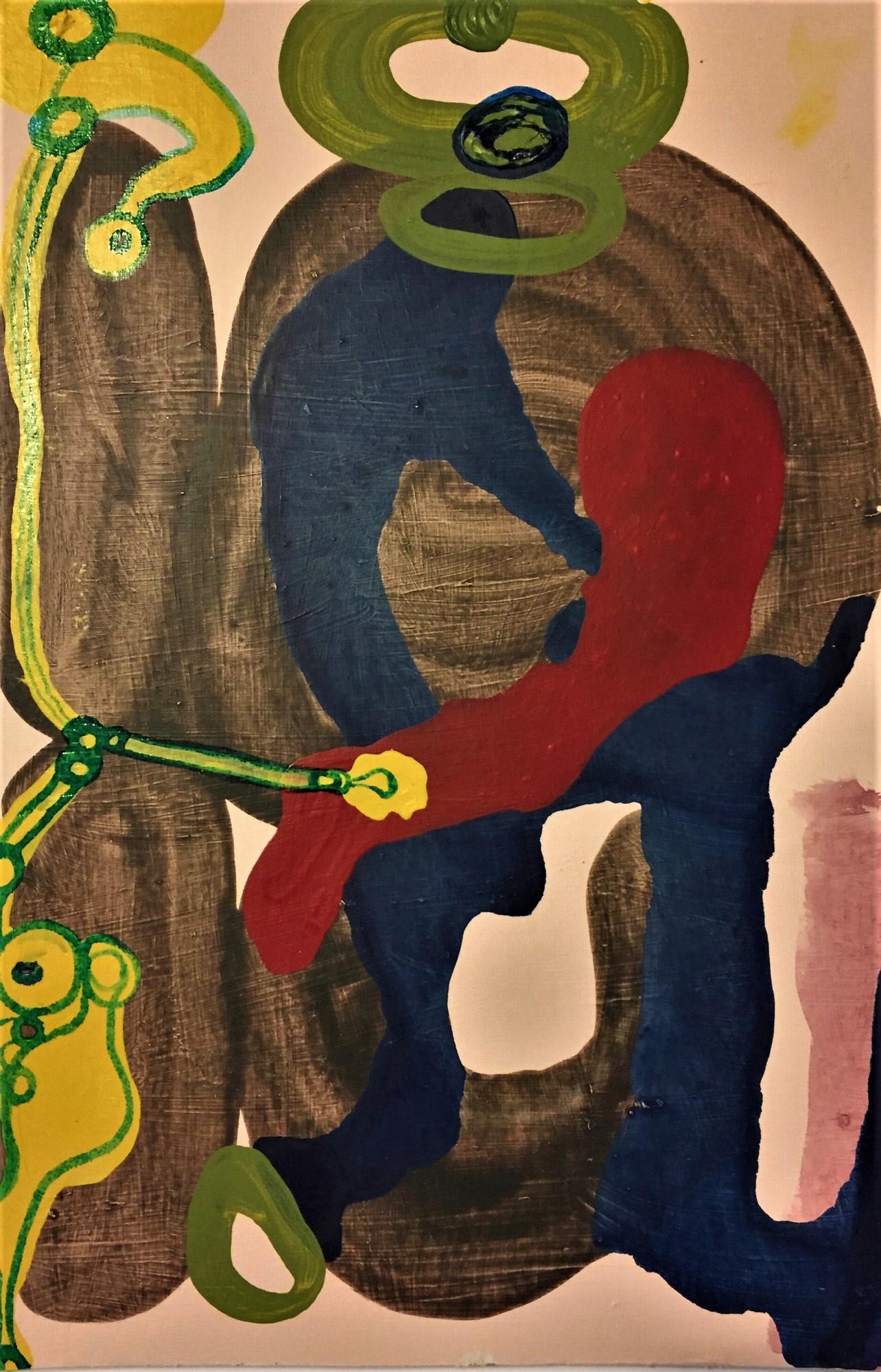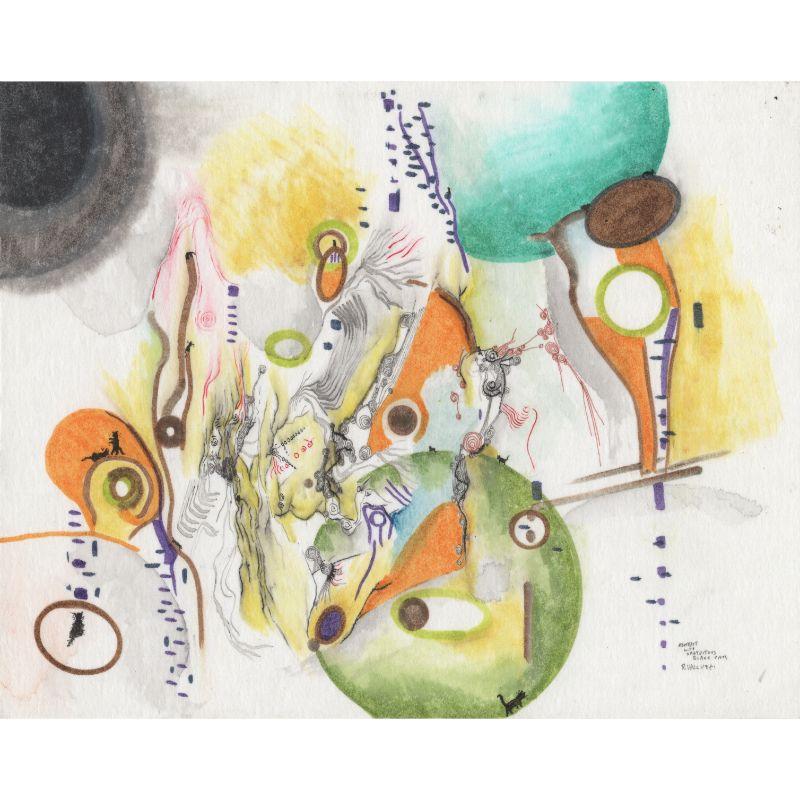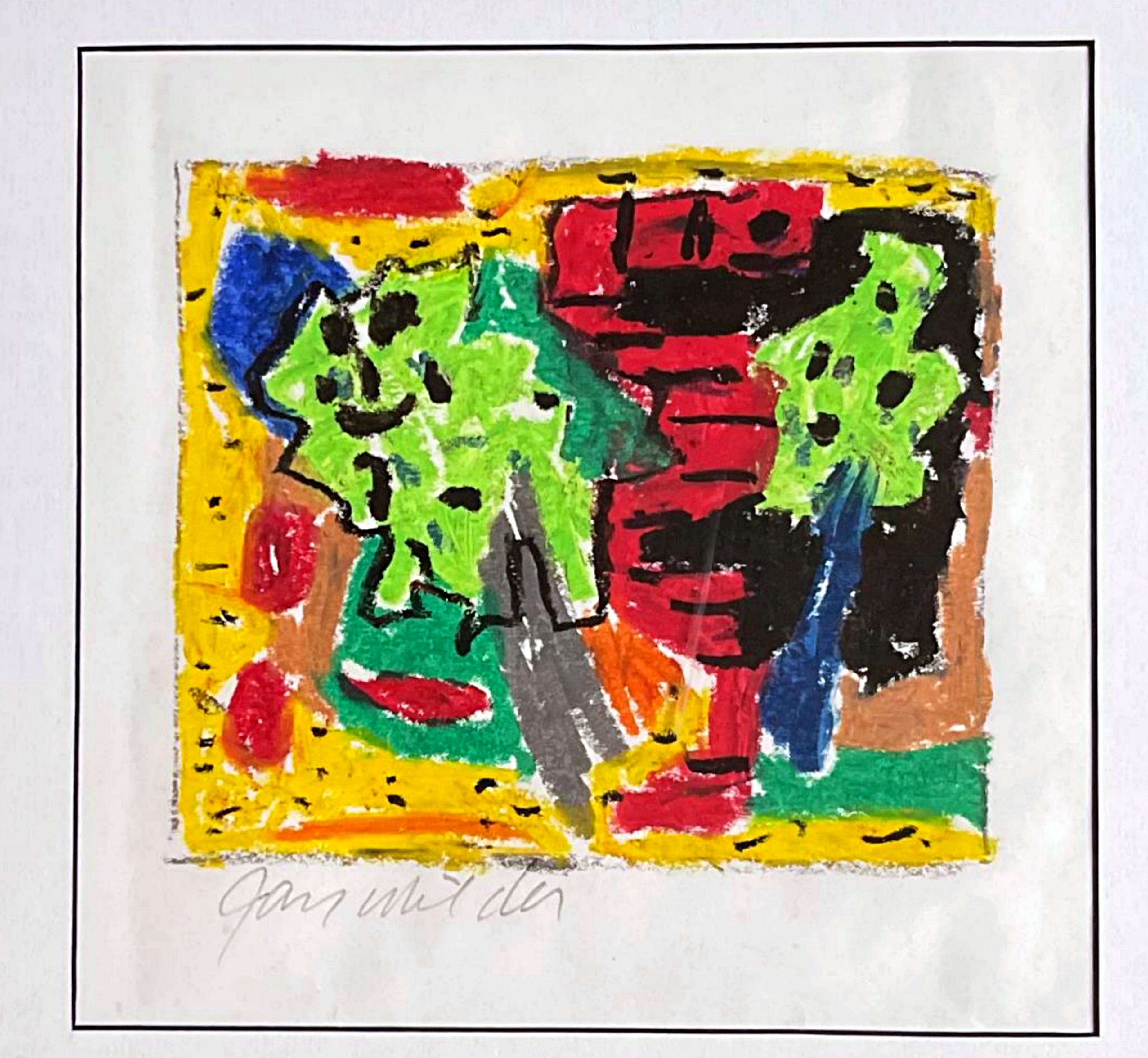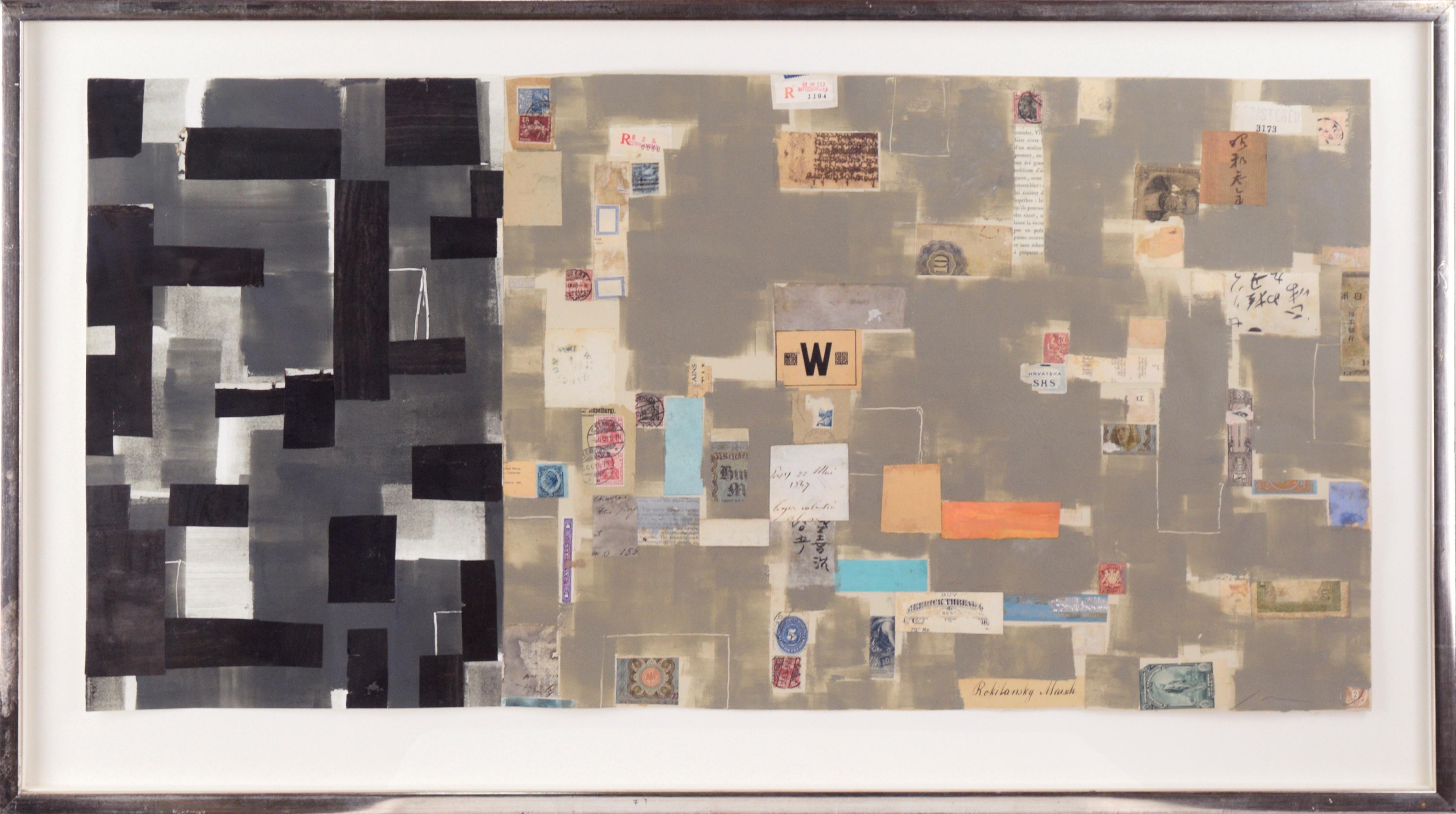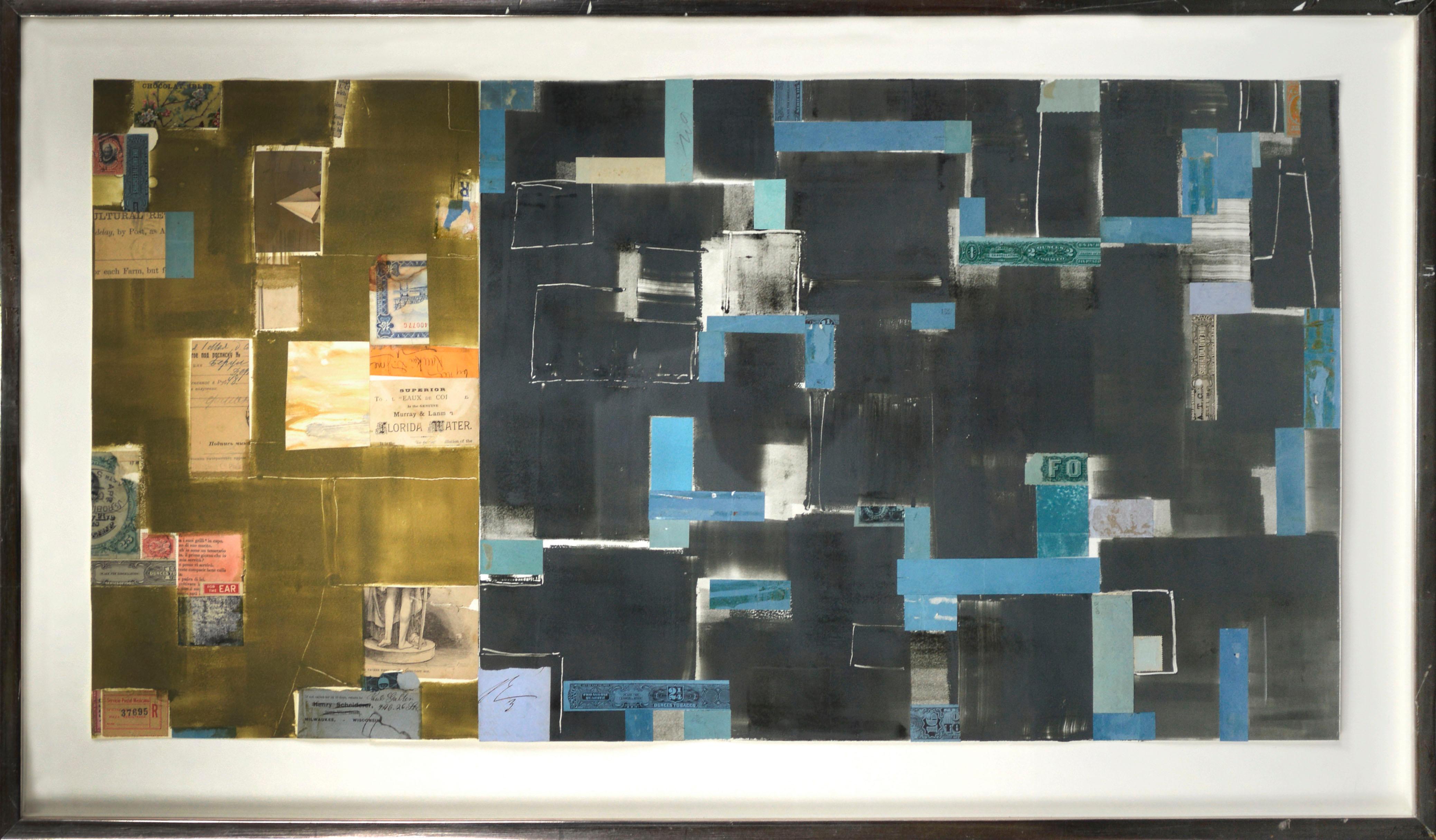Items Similar to Untitled Abstract Expressionist sculptural painting on paper, signed, Knoedler
Want more images or videos?
Request additional images or videos from the seller
1 of 9
Herbert FerberUntitled Abstract Expressionist sculptural painting on paper, signed, Knoedler1968
1968
About the Item
Herbert Ferber
Untitled, 1968
Unique Ink and color wash on paper
Hand signed and dated by the artist on the front
Framed with original Knoedler Gallery label (under the respected director Larry Rubin)
This lovely untitled sculptural drawing done by the renowned abstract expressionist sculptor and painter, Herbert Ferber. Hand signed and dated by the artist on the front. Framed and ready to hang and in good vintage condition. The work bears the original Knoedler gallery label, from under the blemish free direction of Lawrence Rubin.
Measurements:
Frame:
16 1/4 x 16 1/4 x 1/2 inches
Sheet:
11 x 14 inches
Provenance:
Bears the Knoedler and Company label on the back. From the original Knoedler gallery under Larry Rubin.
Herbert Ferber Biography
(1906-1991)
One of the few Abstract Expressionist artists working in three dimensions, Herbert Ferber explored the concerns of his age in dynamic and visually interesting sculptures over the course of a career that uniquely expresses the collective artistic vocabulary at midcentury. In a body of work that spans several decades, Ferber’s sculptural practice develops slowly and thoughtfully to incorporate elements of Surrealism, social realism, and expressionism.
After some early work with direct wood carving, Ferber moved “beyond the monolith” in the early 1940s in the form of modeled bronze. (1) This allowed the artist to explore more attenuated and expressionist form and opened up his practice to some of the Surrealist influence in which his contemporaries were also interested. This period also saw Ferber’s move into complete abstraction, his thinned forms becoming ever more like drawing in space. Drawing was in fact an important component of Ferber’s process, and several preparatory works on paper preceded each sculptural work. Drawing “enabled Ferber to loosen and open up his shapes and to free himself from a specific, literal image and move toward simplification and fluency” in sculpture. (2)
In the 1950s and 60s Ferber explored the relationship between organic and geometric line, most notably in his series of “cage” sculptures. These large-scale works featured sweeping organic forms contained within strictly rectilinear framing devices. The artist also plays with the boundaries of balance and counterbalance in sculptures both large and small. This untitled work from 1966 embodies both of these directions in Ferber’s work. The organic form of the swirling circle is interrupted by the aggressively geometric jaggedness of Ferber’s lines in space. The entire form also leans dynamically to one side, counterbalanced by the small base on which it stands.
Born in New York City in 1906, Ferber attended the City College of New York from 1923 until 1926, majoring in science while concurrently developing an interest in fine art and the humanities. He went on to study dentistry and oral surgery at Columbia University, where he received his D.D.S. While in medical school, Ferber was required to make anatomical drawings; this is where he first discovered his skill as an artist. While attending dentistry school, he also enrolled at the Beaux Arts Institute of Design from 1927 through 1930. Ferber did, in fact, work as a practicing dentist for several years and also taught dentistry part time at Columbia through the mid 1970s when he fully devoted himself to sculpture.
In the years 1930-1931, Ferber made his first woodcarvings, and by the end of 1932 he had fully come into his own within the medium. His early work was representative – often of the human form – which is likely a direct response to his anatomy drawings as a medical student. His work became increasingly more abstract as the years went on. Following his strict representational period, Ferber developed a growing concern for social causes. He work took a particularly social-realist turn with his interest in the changing social, political, and economic climate of the 1930s. It was at this same time, around 1936, that he joined a John Reed Club and the Artist’s Union. While participating in these organizations he attended talks by influential social-realist Mexican muralists José Clemente Orozco and David Alfaro Siqueiros, who were visiting New York to publicize social-realist art. However, by the late 1930s Ferber had become disillusioned with Stalinist politics and began to break away from John Reed and the Artist’s Union. Social-realist themes remained somewhat present in his work moving forward, but in a less literal manner. His first one-man show was comprised of works in wood and was held in 1937 at Midtown Gallery in New York. Before the end of the 1940s, he had given up wood as a medium, insisting that he had done all that he could with the material.
As for many American artists who spent their formative years on this side of the Atlantic, Ferber’s first trip to Europe was especially influential. In 1938 he visited a covey of churches and cathedrals in both France and Italy and was particularly influenced by Romanesque sculpture, especially that of Moissac, Souillac, and Carcassone. Between the years of 1938 and 1945, his work was heavily affected by what he termed the “false perspective” of Romanesque capitals.
As Ferber’s career progressed, he experimented more and more with different types of metal and different ways to achieve a sound structural form. For Ferber, though, materials were a matter of pragmatics. He often spoke strongly against the fetishization of materials – his greatest critique of the Bauhaus. He believed that ideas were at the heart of art
making, not techniques or materials (3). A notable part of Ferber’s process, a direct product of his influence from Henry Moore, is the drawing phase. Scholar William C. Agee
goes so far as to call Ferber a “compulsive draftsman,” whose studies are full blown wash drawings that are similar to paintings. Agee cites Ferber’s drawing process as a significant strain in his identity as an artist. His interest in drawing combined with his affection for Miró and Picasso indicates that Ferber, Alexander Calder, David Smith, and other artists of that generation no longer wished to draw a distinct delineation between painting and sculpture (4). Ferber, Smith, Calder, and Theodore Roszak all began as painters before shifting into three dimensions, and were thus more inclined to ignore the barriers between the mediums. There is evidence of this approach to sculpture in Ferber’s work such as Metamorphosis I that tends towards a more attenuated line, and openness and a thinness that otherwise looks painted in space.
By 1946, Ferber was belatedly, but deeply immersed in Surrealism. This shift in style and poetics was the result of Ferber’s contact with the artists of the Betty Parsons Gallery, which he joined in the same year. These artists and others from Kootz Gallery that included Jackson Pollock, William Baziotes, Mark Rothko, and others were all exploring the possibilities of Surrealism in their work. Ferber’s new interest in Surrealist ideas such as impulse, the unconscious, and mythologies radically altered his art making. Agee cites Rothko’s Surrealist paintings from 1944-1946 as major influences in Ferber’s own work at the time.
Between 1949 and 1950, Ferber had reasserted his interest in the work of Julio Gonzalez, Picasso’s sculpture mentor and an influential figure in Ferber’s early sculpting years. He became more conscientious of the formal elements of artmaking once again, and slowly moved away from his more radical Surrealist tendencies. This more restrained approach forced a physical shift in aesthetic as well, and his work moved more toward verticality and abstraction. The artist experimented with wall sculpture at this time, but soon he was taken with the possibilities of space. Minimalism, a contemporaneous movement, was equally concerned with the viewer’s engagement with space and how the built form affected this engagement. While Ferber’s work could hardly be described as Minimalist, it was in dialogue with similar phenomenological concepts. The next step in his interest in space was in his integration of a frame and later a “roof and wall” structure as part of the sculpture. This suggestion of an enclosed room was a byproduct of the artist’s interest in creating a room-sized environment (5).
By 1958, Ferber was in close contact with art critic and historian E.C. Goossen. Together, they developed a growing concern for emulating the effect on the viewer caused by large-scale painting in three dimensions. Goossen wrote about the topic in an article titled “The Big Canvas.” The two shared a firm belief in the intimacy one experienced when engaging with a painting, especially on a grand scale. While Ferber claims that he never stopped painting, this year marks an important integration of the medium in his own art making. Work from this point forward shows an increased awareness of somehow injecting a painterly presence into his sculptures. He was still working on thinning the line of demarcation between the two mediums.
Ferber’s work can be found in the collections of the Albright-Knox Art Gallery, Buffalo; the Cantor Arts Center, Stanford University, Palo Alto; the Dallas Museum of Art; the Honolulu Museum of Art; the National Gallery of Art, Washington, D.C.; the Newark Museum; the Pennsylvania Academy of the Fine Arts; the Whitney Museum of American Art, New York; the Jewish Museum, New York; and the Yale University Art Gallery, New Haven, among others. Ferber died in 1991 in North Egremont, Massachusetts
- Creator:Herbert Ferber (1906-1991, American)
- Creation Year:1968
- Dimensions:Height: 16.25 in (41.28 cm)Width: 16.25 in (41.28 cm)Depth: 0.5 in (1.27 cm)
- Medium:
- Movement & Style:
- Period:
- Condition:In good vintage condition. Minor rippling, but otherwise very good condition. In vintage frame; frames are not guaranteed.
- Gallery Location:New York, NY
- Reference Number:1stDibs: LU1745212443672
About the Seller
5.0
Platinum Seller
These expertly vetted sellers are 1stDibs' most experienced sellers and are rated highest by our customers.
Established in 2007
1stDibs seller since 2022
289 sales on 1stDibs
Typical response time: 1 hour
- ShippingRetrieving quote...Ships From: New York, NY
- Return PolicyA return for this item may be initiated within 1 day of delivery.
More From This SellerView All
- Study for Bull and CondorBy Jacques LipchitzLocated in New York, NYJACQUES LIPCHITZ Study for Bull and Condor, 1964 Original Ink on gouache on Paper drawing and signed lower left front Unique This work is from the Collection of renowned art dealers...Category
1960s Abstract Expressionist Abstract Drawings and Watercolors
MaterialsInk, Gouache
- Project for Sculpture in Chalon-sur-Saône (unique sculptural drawing for France)By Mark di SuveroLocated in New York, NYMark di Suvero Project for Sculpture in Chalon-sur-Saône, 1992 Marker, Watercolor and Ink Wash on Paper. Hand signed and dated by artist on lower right front Frame included The rare ...Category
1990s Abstract Expressionist Abstract Drawings and Watercolors
MaterialsInk, Watercolor, Permanent Marker
- Mid Century Modern Abstract Expressionist painting on paper by renowned artistBy Ron GorchovLocated in New York, NYRon Gorchov Untitled early 1960s Abstract Expressionist work, 1962 Ink and watercolor painting on paper Signed and dated in black ink lower left recto Frame included: elegantly floa...Category
1960s Abstract Expressionist Abstract Drawings and Watercolors
MaterialsInk, Watercolor
- Composition in Blue (mid century modern Abstract Expressionist signed/N, UniqueBy Hans HofmannLocated in New York, NYHans Hofmann Composition in Blue, 1952 Color silkscreen with unique hand painted gouache additions Hand signed and numbered on the front in ink Published by Esther Gentle and 167 Gal...Category
1950s Abstract Expressionist Abstract Prints
MaterialsInk, Gouache, Screen
- Yayoi's Guitar unique signed work on paper by internationally renowned sculptorBy Mark di SuveroLocated in New York, NYMark di Suvero Yayoi's Guitar, 1980 Ink wash drawing Signed and titled in red ink on the front Frame included (held in original vintage frame) Unique 1980 drawing by sculptor Mark di...Category
1980s Abstract Expressionist Abstract Drawings and Watercolors
MaterialsInk, Watercolor, Permanent Marker, Mixed Media
- Untitled Abstract Expressionist painting Kabbalah inspired mystical abstractBy Jay MilderLocated in New York, NYJAY MILDER Untitled, ca. 1987 Gouache on Paper hand signed in pencil, lower left. Image is 9 square inches; framed it's 16 square inches Frame included: held in the original vintage frame A protege of Hans Hofmann, Milder also studied Jewish mysticism and Kaballah. Poignant framed color gouache painting on paper by second generation Abstract Expressionist painter Jay Milder, a former student of Hans Hofmann, whose work has been greatly informed by his background and interest in Jewish mysticism and Kaballah. Most recently, Milder had been represented by the Lohin Geduld Gallery in Manhattan and Eric Firestone. The visible sheet measures approximately 9 square inches. Framed, the work measures 16 square inches. Artist's official biography: JAY MILDER Born 1934 in Omaha, Nebraska, Jay Milder became a noted abstract painter in the New York art scene in 1958 when he, Bob Thompson, and Red Grooms founded City Gallery. They were all influenced by Abstract Expressionism, but closer to Willem De Kooning than Jackson Pollock because all three were committed to figurative work. Milder was originally shown at The Allan Stone Gallery and then when Martha Jackson took over as Milder’s dealer, her client, Walter Chrysler...Category
1980s Abstract Expressionist Abstract Drawings and Watercolors
MaterialsGouache, Mixed Media, Oil
You May Also Like
- Basement SystemsBy Kory TwaddleLocated in Kansas City, MOArtist : Kory Twaddle Title : Basement Systems Materials : Acrylic, tempera, gouache, and glitter glue on cardboard drawing pad back Date : 2019 Dimensions : 18 x 12 x .2 in. Kory ...Category
2010s Abstract Expressionist Mixed Media
MaterialsPaint, Paper, Conté, Charcoal, India Ink, Acrylic, Tempera, Watercolor, ...
- Abstract with Cats, Original Signed Contemporary Abstract Expressionist WorkLocated in Boston, MAAbstract with Cats, Original Contemporary Abstract Expressionist Work, 2019 8" x 10" (HxW) Ink and Watercolor on Paper Hand-signed by the artist. An abstract expressionist work fill...Category
21st Century and Contemporary Abstract Expressionist Abstract Drawings a...
MaterialsPaper, Ink, Watercolor
- Contemporary Abstract Painting with Chine Colle and Watercolor, CollageBy Michael PaukerLocated in Soquel, CABeautiful contemporary painting (Monotype) in primarily grey and black, with found object collage composition of stamps, money, various types of paper, and watercolor by Michael Pauk...Category
2010s Abstract Expressionist Abstract Drawings and Watercolors
MaterialsPaper, Watercolor
- Army Green, Black, & Blue Chine Colle Watercolor with Found Object CollageBy Michael PaukerLocated in Soquel, CABeautiful abstract expressionist collage by Bay Area artist Michael Pauker (American, b.1957). Composed of two contrasting sections; army green with orange and warm neutral found obj...Category
21st Century and Contemporary Abstract Expressionist Abstract Drawings a...
MaterialsPaper, Found Objects, Watercolor
- Light Blue and Brown Chine Colle Watercolor with Found Object CollageBy Michael PaukerLocated in Soquel, CABeautiful abstract expressionist collage by Bay Area artist Michael Pauker (American, b.1957). Composed of two contrasting sections of light blue and brown, this piece has layers of ...Category
21st Century and Contemporary Abstract Expressionist Abstract Drawings a...
MaterialsFound Objects, Paper, Watercolor
- Information Superhighway, Original Contemporary Abstract Expressionist DrawingLocated in Boston, MAInformation Superhighway, Original Contemporary Abstract Expressionist Drawing 16" x 20" Ink with Silverpoint, Paint, and Metal Foil on Paper Panel This highly geometric abstract ex...Category
21st Century and Contemporary Abstract Expressionist Abstract Drawings a...
MaterialsFoil
Recently Viewed
View AllMore Ways To Browse
Vintage Abstract Expressionist
James Mccahon
Murray Moss
Robert Jahns
Selena Beaudry
George Hammond Steel
Hal Fischer
Jerry Terry
Nancy Prophet
Used Mechanics Tool Boxes
Gilmore Girls
Mai Houston
Miki Leal
Calder Birds In Flight
Sculpture Pedro Reyes
Vintage Omega Poster
Dali Little Prince
Japanese Bath Painting By Portland Artist
